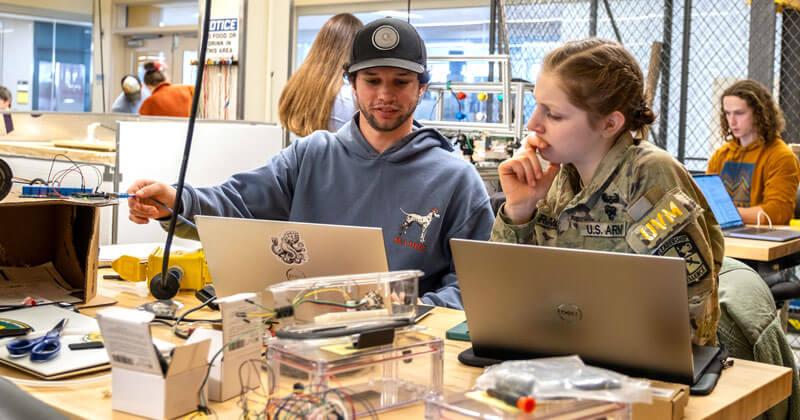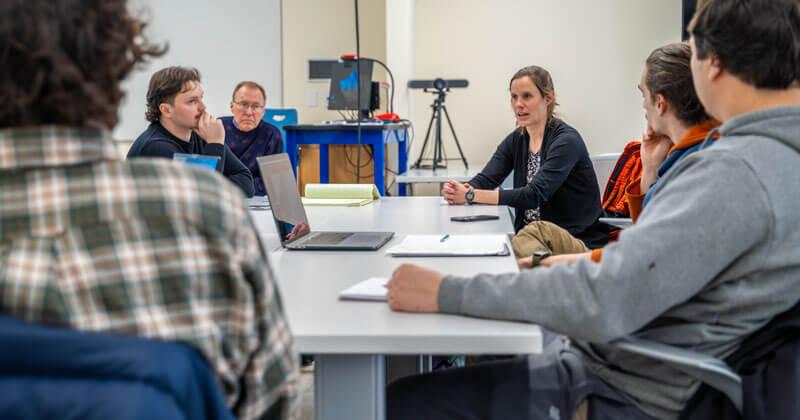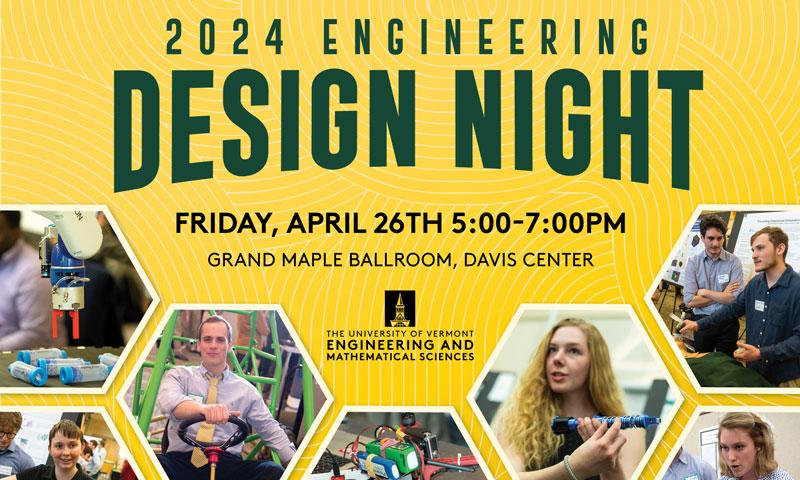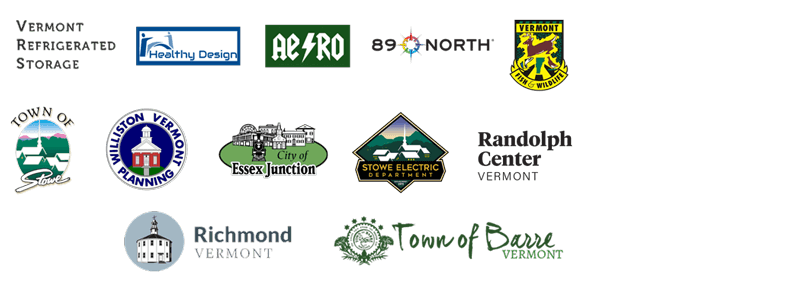These projects originate as problem statements submitted by local companies, individuals, non-profits, students, or UVM Faculty. The outcome for each project is unique as students investigate the client’s needs and create an engineering design that solves the client’s unique challenge.
Seniors in our Mechanical and Electrical Engineering programs will work on projects in the Senior Experience in Engineering Design (SEED) capstone course series.
Learn more about the Senior Experience in Engineering Design (SEED)
Seniors in our Civil Engineering and Environmental Engineering programs will work on projects in the Civil and Environmental Engineering (CEnvE) Senior Capstone Design course series.
Learn more about the Civil and Environmental Engineering (CEnvE) Senior Capstone Design
A culminating, team-based design project
An example project where a Senior Experience in Engineering Design (SEED) team worked together to develop a solution for Burton, the pioneering Burlington-based snowboard company.
Senior Experience in Engineering Design

Seniors in Mechanical and Electrical Engineering programs work in teams to address complex and multidisciplinary problems. SEED projects originate as problem statements from companies, non-profits, faculty, or students. The projects are supported by the local engineering community and engineering faculty at UVM.
From a company's perspective, a SEED project offers the opportunity to work directly with senior engineering students, take a fresh look at a long-standing problem, or explore new ideas for their company. Students are eager to engage in engineering practice as preparation for work in industry and to apply the theory they have been learning in school. Course material related to design project fundamentals and the involvement of industry contacts add to the student’s education and strengthen links between industry and Engineering at UVM.
Engineering Design Night
Frequently Asked Questions
Why participate in a SEED Project
There are many reasons to submit a project and participate in SEED depending on your perspective.
Engineering Company:
- SEED projects offer the opportunity to work directly with seniors who are likely to be candidates for entry-level engineering positions when they graduate.
- The company gets to take a long-standing problem off the back burner for minimal cost.
- The company can look into a new idea or concept that may be too risky to use existing engineer resources to develop.
- Engineers often consider the mentoring role a welcome addition to their more typical duties.
Non-Engineering Company or Non-Profits:
- SEED projects offer the opportunity to solve a problem for your company that you may not be able to afford using traditional engineering firms.
- The company can look into a new idea, concept or product they don’t currently have the skills to design and build.
Students:
- SEED projects offer the opportunity to go after a new or old idea in an area you have a deep interest.
- The student gets to see the design process from both the client and the engineering perspective.
- The student gets an opportunity to work directly with the SEED instructor to steer their project toward their definition of success.
Faculty:
- SEED projects offer an opportunity to work with undergraduate students who share a passion for your area of research in small groups.
- The students can move forward engineering related research with a finite and well-defined deliverables at the end of the spring semester.
- Projects can be designed to support non-engineering related research.
Charitable Donor:
- Directly fund projects that otherwise would not move forward due to funding gaps.
- An opportunity to donate to the engineering program and see tangible results via a demonstrable project over the course of an academic year.
- Supports innovation in an area of interest.
How do I submit a project for consideration?
If you are interested in sponsoring a SEED project, you can submit your project idea directly via the following link, Project Submittal. This link will bring you to our project management software EduSourced used for the course. A user login is required to submit and track all projects. If you have submitted projects in the past, you should use the same account to submit additional projects. Submitting a project does not hold you accountable to sponsor the project nor does it guarantee acceptance into the SEED program.
If you have specific questions about the program or want to discuss a project idea prior to submittal, contact the SEED program instructor via seed@uvm.edu.
What is the project submission timeline and priority
Projects need to be submitted prior to the start of the Fall semester to be considered for the SEED program. We often have more projects submitted than we have students available to work on projects. In an effort to gather and define projects earlier, we give priority to projects based on project accepted date and sponsorship level. Projects with Priority 1 will be assigned to students first. Projects with Priority 2 will be assigned to students second. Projects with Priority 3 will be assigned to students last.
Priority 1: Submitted prior to June 1 or Program/Innovation Sponsor
Priority 2: Submitted prior to July 1, Team Sponsor, or returning Startup Sponsers
Priority 3: Submitted prior to First Day of Class or all other sponsorship levels.
How does a submitted project get accepted in the SEED program?
All projects submitted via the project management software are reviewed by the SEED instructor. The instructor will work with the client to verify the scope, complexity and budget are appropriate for the course and students skill level. Once details have been agreed upon, the client and UVM sign a Letter of Understanding (LOU). The LOU is a non-binding agreement that outlines the expectations of both the client and UVM for the duration of the course. At this point the project is considered Accepted and awaits selection by students. The first week of each Fall Semester the students rank the projects in order of interest. Students are assigned to projects based on their interest level and the project priority levels as defined in the next section.
What are the clients responsibilities?
The client agrees to assign a liaison to the project who will attend a SEED Project Pitch Event to pitch the project to prospective students in the fall. The liaison is required to periodically and promptly supply information to students when needed. They are asked to review and approve the proposed budget, deliverables and support communication between UVM and the client. The liaison will be encouraged to attend two separate design reviews through the semesters either at UVM or the clients location. In addition, we ask them to attend the UVM Design Night event at the end of the spring semester to support their design team and the other SEED projects.
We ask clients to recognize these are students who are learning the engineering design process. They are asked to meet the needs of the client and the course, which do not always align perfectly. We appreciate your willingness to allow for some flexibility in this process, making the learning process as rich as possible.
What does sponsoring a SEED project cost?
The cost of a SEED project is broken into two parts, sponsorship fee, and material costs. Sponsorship fees are directly used to support the costs to run the program. The costs include, but are not limited to, special tools, safety training and equipment, lab supplies, machine shop resources, 3D printing, course administration, etc. These fees are critical to allowing the program to provide the students the resources and flexibility they need to complete a successful project.
The second cost of the program is the material costs. These costs are very dependent on the type of project you sponsor. We ask all project sponsors to be prepared to spend at least $1k on material costs over the course of the project. The students are presented the budget at the beginning of the course and will work within those limits. If additional funding is needed, the SEED instructor will work with the client to determine need and source of additional funds.
Project sponsorship levels are as follows:
- Non-Profit – no sponsorship fee, material costs only
- Student – no sponsorship fee, $1000 for material costs
- Startup Company (approx. 1 - 10 employees) - $1k sponsorship + $1k Material costs
- Team Sponsor (approx. 11 - 100 employees) - $5k sponsorship, includes up to $2.5k of material costs
- Program Sponsor (approx. 100+ employees) - $10k sponsorship, includes up to $6k of material costs
- Innovation Sponsor – Charitable donation, 20% sponsorship and 80% for material costs
What happens during the year?
Project Management:
The SEED program uses the SCRUM framework for project managment. Each semester is broken into 3 or 4 Sprints. Each Sprint is planned and has a goal that is demonstrated to the client with a physical Increment. The teams review these increments with the clients for feedback on progress and to adjust the design if needed.
During the fall semester the students will:
- Create team roles and learn how to work as a team.
- Understand and revise the problem statement as necessary
- Perform a search of existing patents, products, literature, etc.
- Investigate the design space and select a preliminary design concept (or two)
- Create several prototype iterations for evaluation
- Perform critical analyses for the design
- Create a list of Engineering Specifications
- Present a Preliminary Design Review
During the spring semester the students will:
- Continue to design, build and test their project
- Perform a Failure Modes Effects Analysis of their project
- Demonstrate their working project
- Create a poster and present their project at Design Night
- Present a Final Design Review
- Generate and deliver a Final Design Report, Technical Documentation Package, and working project
How is intellectual property handled?
UVM has a standard Non-Disclosure Agreement (NDA) that can be signed by all students in the event you are concerned about disclosing confidential information. In addition, we have a standard form where students will assign all invention rights to the client if a patent is developed as part of the course. The students still earn the right to have their name on the patent, but the rights to the patent will belong to the client. UVM can also use your company-supplied NDA, but requires sufficient time for a review by our internal counsel before making a project active.
What resources available to SEED teams?
Students in the SEED program will use the SEED Lab for most of their project development. The new lab is designed to promote group collaboration and provide the basic needs of most teams. Features include:
- Locked cabinets to secure each teams project
- Large computer screens for group collaboration and presentations
- Fume hood
- Part vending for standard fasteners and other common parts
- Basic electrical equipment such as power supplies, oscilloscopes, function generator etc.
- Basic hand tools
- Soldering station
- Multiprocessor Virtual Machines for simulations
In addition to the SEED Lab, students have access to the following resources in CEMS.
Machine Shop
- Water jet
- 6 axis CNC Machine
- Lathe
- Milling machine
- Drill press
- other tools
The Fab Lab
- 3D Printing
- Laser cutting machine
- Other Research Lab Tools
- Tensile strength tester
- Vibration table
- Wind Tunnel
- 1 layer Printed Circuit Board Manufacturing
UVM Woodshop
- Table saw
- Router
- Bandsaw
- Lathe
- Jigsaw
- Belt sanders
- Drill press
Teaching Lab
- SEED students can obtain access to the teaching labs used for various courses here in CEMS. A comprehensive list of lab equipment can be found by visiting the teaching lab website.
Civil and Environmental Engineering (CEnvE) Senior Capstone Design

Our Civil Engineering and Environmental Engineering graduates have a multi-disciplinary senior design experience in their final year. Currently, it is an intense 30-week long experience. For the past six years, almost all the capstone projects have been service-learning projects where students work with local communities, towns, and non-profits on their Civil and/or Environmental Engineering related needs. We select projects that offer a solid design experience and at the same time promote sustainability and civic engagement. For each project, students consider multiple design alternatives and suggest recommendations based on costs and social and environmental impacts. They write comprehensive technical reports and make presentations to external evaluators, faculty, fellow students, and community partners.
Why sponsor a CEnvE project?
There are many reasons to sponsor a project and participate in CEnvE, depending on your perspective:
Governmental organizations:
- CEnvE projects offer the opportunity to work directly with senior level students who will soon enter the engineering workforce.
- The organization gets to take a long-standing problem off the back burner with minimal effort from existing staff.
- The organization can explore a new idea or concept only needing limited existing staff resources to investigate and develop.
- Engineers and scientists in these organizations usually consider the project interaction with students a welcome addition to their more typical duties.
Non-Governmental organizations or Non-Profits:
- CEnvE projects offer the opportunity to solve a problem for your organization that you may not be able to afford using traditional engineering resources.
- The organization can evaluate a new idea or concept they don’t currently have the skills to investigate, engineer, and design.
Staff and Faculty:
- CEnvE projects offer an opportunity to work with small groups of undergraduate students who share a passion for your area of research.
- The students can advance engineering related design or research toward an outcome to be described in a well-defined project investigation report.
Engineering Design Competition Sponsors:
- Support innovation in an area of interest and need.
- The competition creates an opportunity and motivation for advancing a special initiative via a defined project goal over the course of an academic year.
How do I submit a project for consideration?
If you are interested in sponsoring a CEnvE project, you can submit your project idea directly via the following link, CEnvE Project Submittal. This link will bring you to our project management software EduSourced used for the course. A user login is required to submit and track all projects. If you have submitted projects in the past, you should use the same account to submit additional projects.
If you have specific questions about the program or want to discuss a project idea prior to submittal, contact the CEnvE program instructor via jelens@uvm.edu.
What is the process to get a project accepted ?
All projects submitted via the project management software are reviewed by the capstone course instructor. The instructor will work with the client to verify the scope, complexity, schedule, and desired outcomes/deliverables are appropriate for the course and students’ skill level. Once details have been agreed upon, the client and UVM discuss the project Letter of Understanding (LOU). The LOU agreement outlines the expectations of both the client and the student team for the duration of the course. At this point the project is considered Accepted and awaits selection by students. At the beginning of the Fall Semester, the projects are presented to the students who rank the projects in order of interest. The instructor subsequently assigns students to projects, based on students’ interests, background, and applicable skills. If your project has enough interest, it will become active and the student team will start working on your project. We cannot guarantee that all projects will move forward.
What are the client's responsibilities?
The client agrees to assign a liaison to the project who will attend a CEnvE project kickoff meeting with the student team. The liaison is required to regularly communicate with the students and promptly supply information to students when needed. The client liaison needs to review and approve the students’ proposed scope, deliverables, and schedule proposal and support communication between UVM and the client. The liaison is to provide three separate design reviews through the two-semester sequence. In addition, we invite the liaisons to attend the UVM Design Night event at the end of the spring semester to support their design team and the other CEnvE projects.
We ask clients to recognize these are students who are learning the engineering design process. They are asked to meet the needs of the client and the course, which do not always align perfectly. We appreciate your willingness to allow for some flexibility in this process, making the learning process as rich as possible.
What does sponsoring a CEnvE capstone project cost?
There is no formal fee structure. We welcome sponsorship funding from clients, on a voluntary basis, such as to help reimburse students’ travel expenses to project sites and costs of project-specific consumables. We recognize that sponsorship funding is not possible for some clients and appreciate that their time spent interacting with the students is a valuable non-monetary form of sponsorship.
What happens during the year?
In the fall semester, students will:
- Investigate the problem/need to understand the client’s needs from the student project
- Investigate existing standards of practice and new developments in that area of practice
- Develop a scope of work, deliverables, and schedule for client review and approval
- Obtain background information, relevant field data, perform lab tests, and prepare a background/data/needs report
- Provide a Preliminary Design Report with alternatives and their recommended design concept
In the spring semester, students will:
- Review alternatives with the client and confirm the client’s preferred final design concept
- Perform engineering to expand upon the chosen final design concept
- Develop a cost estimate and identify project permitting requirements
- Prepare final design plans and a corresponding Final Design Report
- Present the project at the Design Night program at the end of the semester
- Present the project in a Final Design Review session to the client, outside reviewers, faculty and students at the end of the semester



